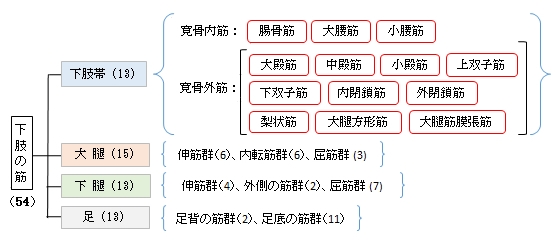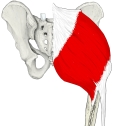大殿筋 ( だいでんきん、英: gluteus maximus muscle )
・ 概 要 |
・ 作 用 |
・ イラスト掲載サイト |
|
・ イラスト |
・ 神経 / 脈管 |
||
・ 起始 / 停止 |
・ Wikipedia |
![]()


![]()

・骨盤の前部に位置する腸腰筋は足を上げるのに主要な働きをするのに対して、骨盤の後部に位置する殿筋群
は足を後方に引くときに働く。
・「日本人体解剖学」では筋腹を 2層 (浅層・深層)に区別している。
筋連結 : 中殿筋、梨状筋、大腿方形筋、外側広筋、中間広筋、大腿筋膜張筋、小内転筋、大腿二頭筋(短頭)
以下は「船戸和也のHP」の解説文となる。
「大臀筋は大腿を伸展する主力筋で、とくに歩行の際重要である。中臀筋や小臀筋(小さな臀部の筋群)と同様、大きな臀部の筋である大臀筋も発生的には伸筋群である。 仙骨と尾骨の辺縁、後臀筋線より後方の腸骨稜、胸腰筋膜、そして仙結節靭帯などから起始する。
その厚い筋線維束は斜め下方へ走り、広い停止腱となる。その停止域は近位では大腿筋膜、腸脛靱帯に放散する。また、臀筋粗面よりも遠位で外側筋間中隔より上の粗線外側唇にも停止する。坐骨包坐骨結節と大臀筋下面の筋膜との間にある。慢性的刺激の結果として(機織工結節、抗夫結節)、臀部に敷物なしに座り仕事をする人々では同包に炎症が起こり、後大腿皮神経を圧迫する。大腿筋の停止腱は転子包によって大転子と離される。臀筋粗面では、大腿筋はふつう他の臀筋との間にあるいくつかの筋間包の上を滑走する。立位では大臀筋下部が坐骨結節をおおう。大腿を屈すると大臀筋下部は頭側に移動する。このため座位では坐骨結節は皮下脂肪上に位置し、皮膚を通して容易に触れる。臀溝はほぼ水平に走り、大臀筋収縮時には深くなるが、大臀筋の下縁をあらわしているわけではなく、同筋走行に対して鋭角的に交わる。
」
![]()
 |
 |
 |
|||
![]()
【 起 始 】 : 腸骨の腸骨翼の外面で後殿筋線の後方、後殿筋線より後方の腸骨稜
【 停 止 】 : 浅層)腸脛靭帯 深層)殿筋粗面(大腿骨)
![]()
股関節を伸展させる。
![]()
・ 神 経 : 下殿神経(L4,L5,S1,S2)
・ 脈 管 : 上殿動脈、 下殿動脈、 内側大腿回旋動脈、 大腿深動脈の第1貫通動脈
The gluteus maximus is the main extensor muscle of the hip. It is the largest and outermost of the three gluteal muscles and makes up a large part of the shape and appearance of each side of the hips. Its thick fleshy mass, in a quadrilateral shape, forms the prominence of the buttocks. The other gluteal muscles are the medius and minimus, and sometimes informally these are collectively referred to as the "glutes".
Its large size is one of the most characteristic features of the muscular system in humans, connected as it is with the power of maintaining the trunk in the erect posture. Other primates have much flatter hips and can not sustain standing erectly.
The muscle is made up of muscle fascicles lying parallel with one another, and collected together into larger bundles separated by fibrous septa.
【Structure】
The gluteus maximus is the outermost muscle of the buttocks. It arises from connections to nearby structures in this area. It arises from the posterior gluteal line of the inner upper ilium, a bone of the pelvis, as well as above it to the iliac crest and slightly below it; from the lower part of the sacrum and the side of the coccyx, the tailbone; from the aponeurosis of the erector spinae (lumbodorsal fascia), the sacrotuberous ligament, and the fascia covering the gluteus medius (gluteal aponeurosis).
The fibers are directed obliquely downward and lateralward;
The gluteus maximus ends in two main areas:
- those forming the upper and larger portion of the muscle, together with the superficial fibers of the lower portion, end in a thick tendinous lamina, which passes across the greater trochanter, and inserts into the iliotibial band of the fascia lata;
- the deeper fibers of the lower portion are inserted into the gluteal tuberosity of the linea aspera, between the vastus lateralis and adductor magnus. If present, the third trochanter also serves as an attachment.
【 語 句 】
・extensor muscle:伸筋 ・gluteal muscles:殿筋群 ・fleshy:多肉質の ・quadrilateral:四辺形の ・buttock:臀部 ・erect posture:直立姿勢 ・primates:霊長類 ・erectly:直立に ・muscle fascicle:筋束 ・fibrous septa:線維中隔 ・posterior gluteal line:後殿筋線 ・ilium:腸骨 ・pelvis:骨盤 ・iliac crest:腸骨稜 ・lamina:薄板 ・greater trochanter:大転子 ・iliotibial band:腸脛靭帯 ・fascia lata:大腿筋膜 ・gluteal tuberosity:殿筋粗面 ・linea aspera:骨粗線 ・vastus lateralis:外側広筋 ・adductor magnus:大内転筋
【Bursae】
Three bursae are usually found in relation with the deep surface of this muscle:
- One of these, of large size, separates it from the greater trochanter;
- a second, (often missing), is situated on the tuberosity of the ischium;
- a third is found between the tendon of the muscle and that of the vastus lateralis.
【Function】
The gluteus maximus straighten the leg at the hip; when the leg is flexed at the hip, the gluteus maximus extends it to bring the leg into a straight line with the body.
Taking its fixed point from below, it acts upon the pelvis, supporting it and the trunk upon the head of the femur; this is particularly obvious in standing on one leg.
Its most powerful action is to cause the body to regain the erect position after stooping, by drawing the pelvis backward, being assisted in this action by the biceps femoris (long head), semitendinosus, semimembranosus, and adductor magnus.
The gluteus maximus is a tensor of the fascia lata, and by its connection with the iliotibial band steadies the femur on the articular surfaces of the tibia during standing, when the extensor muscles are relaxed.
The lower part of the muscle also acts as an adductor and external rotator of the limb. The upper fibers act as abductors of the hip joints.
【 語 句 】
・bursae:bursa(滑液包)の複数形 ・ischium:坐骨 ・head of the femur:大腿骨頭 ・stoop:前かがみになる ・biceps femoris:大腿二頭筋 ・semitendinosus:半腱様筋 ・semimembranosus:半膜様筋 ・tibia:脛骨 ・external rotator:外旋
![]()






